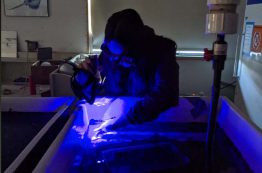Read more »
This tiny coastal fish wears a toothy coat of armor
The ocean is full of otherworldly creatures, seemingly from alien planets with alien capabilities. In most cases, the award for craziest looking critter would go to an invertebrate. But many fish are contenders, too, and there’s an oddly adorable one common in northwest waters. What does it look like? Imagine a golf ball. Now put some googly eyes on it and add a suction cup to its belly.
Read more »UW Environment scientist named 2021 AAAS fellow
Emily Carrington, resident scientist at the UW’s Friday Harbor Laboratories, was named a AAAS Fellow, according to a Jan. 26 announcement by the American Association for the Advancement of Science. She is among 564 new fellows from around the world elected in 2021, who are recognized for “their scientifically and socially distinguished achievements” in science and engineering. Carrington is honored for her research contributions in biomechanics and ecophysiology, as well as efforts to promote diversity and inclusion in science.
Read more at UW News »Glowing fish teeth answer questions about tooth replacement rates
One of the facts of life for humans is the replacement of baby teeth with permanent adult teeth. Whether pulled out prematurely, wiggled loose by eager hands or naturally falling out unexpectedly, this occasion marks an important milestone in the maturation process that is shared amongst all vertebrates in some form. Imagine, though, losing and replacing a tooth every single day.
Read more »Friday Harbor Laboratories' observation system collects and shares real-time data about Salish Sea
Friday Harbor Laboratories (FHL) recently established the Friday Harbor Laboratories Ocean Observatory (FHLOO), vastly expanding their capabilities to collect and share real-time data about the surrounding marine environment. Connected to the larger Northwest Association of Networked Ocean Observing Systems (NANOOS), FHLOO takes continuous seawater measurements such as salinity, temperature, CO2, oxygen and chlorophyll, in addition to monitoring microplankton. While the system has been taking measurements since the summer of 2020, the ability to live-stream its data is new, providing a window into the Salish Sea accessible to researchers, students and the public.
Read more »




